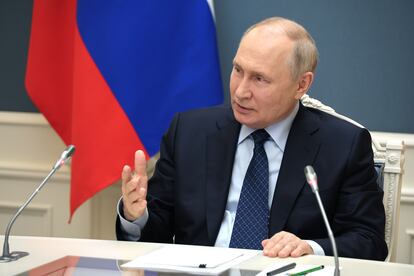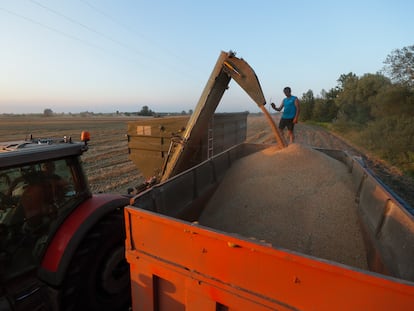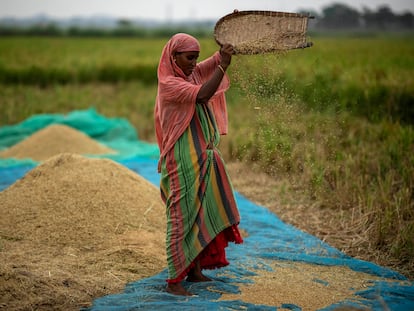Russia’s Putin and Turkey’s Erdogan set to meet amid efforts to repair Ukraine grain deal
The meeting comes just over six weeks after Moscow broke off an agreement partly brokered by Ankara that allowed Ukrainian grain to reach world markets despite the 18-month war

Russian President Vladimir Putin will host Turkish leader Recep Tayyip Erdogan for talks next week, the Kremlin announced Friday, just over six weeks after Moscow broke off a deal brokered by Ankara and the U.N. that allowed Ukrainian grain to reach world markets safely despite the 18-month war.
Kremlin spokesman Dmitry Peskov said Putin and Erdogan would meet Monday in Russia’s Black Sea resort of Sochi. The announcement ended weeks of speculation about when and where the two leaders might meet next as international efforts continue to patch up the Black Sea Grain Initiative, which got agrain and other food to parts of Africa, the Middle East and Asia where hunger is a growing threat.
Ukraine and Russia are both major global suppliers of wheat, barley, sunflower oil and other commodities that developing nations rely on.
Turkey, together with the United Nations, brokered the deal in July 2022 that allowed Ukraine to resume shipping foodstuffs from three Black Sea ports. Under the initiative, ship and cargo inspections were overseen from Turkey, and vessels sailed to and from Ukraine from there. Almost 33,000 tons of grain left Ukraine while the agreement was in effect.
Ankara’s role was key. Turkey is one of Russia’s main trading partners and a logistical hub for Russia’s foreign trade amid Western sanctions. Erdogan calls Putin “my dear friend.”
A separate memorandum that Moscow and the U.N. agreed to at the same time as the Ukraine initiative pledged to help to overcome wartime obstacles to Russian exports of food and fertilizer. Russian officials repeatedly threatened to pull out of the deals and finally did in July, alleging its conditions hadn’t been met.
Russia has complained that restrictions on shipping and insurance have hampered its agricultural exports, but it has shipped record amounts of wheat since last year.
U.N. Secretary-General Antonio Guterres sent Russia a new proposal in hopes of reviving the deal, but it didn’t satisfy Moscow’s demands, Russian Foreign Minister Sergey Russian Foreign Minister Sergey Lavrov said while hosting his Turkish counterpart, Hakan Fidan, for talks in Moscow on Thursday.
Lavrov said he gave the Turkish government a list of actions that the West would have to take in order for Ukraine’s Black Sea exports to resume. The scheduled talks between Putin and Erdogan could help unlock that.
The announcement of Monday’s meeting coincided with the departure of two bulk cargo ships Friday from Ukrainian port city of Yuzhne.
The Liberia-flagged Anna-Theresa and the Ocean Courtesy, traveling under a Marshall Islands flag, were carrying pig iron and iron ore concentrate, Ukrainian Minister of Infrastructure Oleksandr Kubrakov said.
It was not clear under what legal and security circumstances the ships had sailed.
The Ocean Courtesy was headed to Romania’s Black Sea port of Constanta and is estimated to arrive there Saturday afternoon, according to the global ship tracking website MarineTraffic. The website said the Anna-Theresa would reach Varna in Bulgaria the same day.
Meanwhile, Russian officials said Friday that air defenses intercepted drones heading toward three of the country’s western regions. Regional governors said defense systems stopped three drones in the Kursk, Belgorod and Moscow regions.
Moscow airports briefly halted flights but no major damage or injuries were reported, according to Russian authorities.
Drones aimed at targets inside Russia — and blamed by Moscow on Ukraine — have become almost daily occurrences as the war has entered its 19th month and Kyiv’s forces pursue a counteroffensive. Recently, the drones have reached deeper into Russia.
The apparent Ukrainian strategy is to unnerve Russia and pile pressure on Russian President Vladimir Putin, although Kyiv officials normally neither claim nor deny responsibility for attacks on Russian soil.
The Associated Press has not been able to determine whether the drones were launched from Ukraine or inside Russia.
Ukraine’s military intelligence chief, Maj. Gen. Kyrylo Budanov, said in an interview with online outlet The War Zone that “we work from the territory of Russia.” He did not elaborate.
Meanwhile, satellite images analyzed by the AP show that suspected Ukrainian drone attacks late Tuesday destroyed at least two Ilyushin Il-76 military transport planes at a Russian air base.
The transport planes were deliberately targeted, according to Budanov.
The images taken Thursday show Princess Olga Pskov International Airport, which is a dual military-civilian airport about 700 kilometers (400 miles) north of the Ukrainian border and near Estonia and Latvia.
The four-engine Il-76 is the workhorse of the Russian military’s airlift capacity and is able to land and take off in rugged conditions. The Russian military is believed to have over 100 of them in its fleet.
The AP analysis, conducted Friday, showed what appeared to be the blackened hulks of two Il-76s on separate parking pads on the air base’s apron. One included the plane’s tail, the other appeared to show pieces of another aircraft. Fire damage could be seen around the pad.
Eleven other Il-76s were moved off their parking pads into different positions on the airport’s taxiways, possibly in an attempt to make it more difficult for them to be struck again. One was on the runway itself. Another Il-76 remained on the pad, though it wasn’t clear why.
The satellite image was taken at 1:03 p.m. GMT Thursday. Videos on social media Thursday night showed anti-aircraft fire going off around the air base again, though it remained unclear whether it was another attack.
Ukrainian President Volodymyr Zelenskyy said Thursday that his country had developed a weapon that hit a target 700 kilometers (400 miles) away, apparently referencing the air base attack. He described the weapon as being produced by Ukraine’s Ministry of Strategic Industries but gave no other details.
Oleksiy Danilov, secretary of the National Security and Defense Counci of Ukraine, suggested on television Friday that the weapon can fly even further than the distance Zelenskyy mentioned.
Sign up for our weekly newsletter to get more English-language news coverage from EL PAÍS USA Edition
Tu suscripción se está usando en otro dispositivo
¿Quieres añadir otro usuario a tu suscripción?
Si continúas leyendo en este dispositivo, no se podrá leer en el otro.
FlechaTu suscripción se está usando en otro dispositivo y solo puedes acceder a EL PAÍS desde un dispositivo a la vez.
Si quieres compartir tu cuenta, cambia tu suscripción a la modalidad Premium, así podrás añadir otro usuario. Cada uno accederá con su propia cuenta de email, lo que os permitirá personalizar vuestra experiencia en EL PAÍS.
¿Tienes una suscripción de empresa? Accede aquí para contratar más cuentas.
En el caso de no saber quién está usando tu cuenta, te recomendamos cambiar tu contraseña aquí.
Si decides continuar compartiendo tu cuenta, este mensaje se mostrará en tu dispositivo y en el de la otra persona que está usando tu cuenta de forma indefinida, afectando a tu experiencia de lectura. Puedes consultar aquí los términos y condiciones de la suscripción digital.
More information
Archived In
Últimas noticias
Chris Martin, Taylor Swift, Elijah Wood and other famous wedding ‘crashers’
‘How does it feel to be a failure?’: Elizabeth Berkley’s journey from ‘Showgirls’ ridicule to vindication
The story of the Málaga virus: The code that haunted Google’s cybersecurity center director for 30 years
The impact of Ecuador’s mega-prison: A polluted river, cleared forests and military checkpoints
Most viewed
- Christian Louboutin: ‘Young people don’t want to be like their parents. And if their parents wear sneakers, they’re going to look for something else’
- The low-cost creative revolution: How technology is making art accessible to everyone
- Liset Menéndez de la Prida, neuroscientist: ‘It’s not normal to constantly seek pleasure; it’s important to be bored, to be calm’
- All the effects of gentrification in one corner of Mexico’s Colonia Roma
- December Social Security and SSI payments: Dates, double checks and the 2026 COLA increase










































